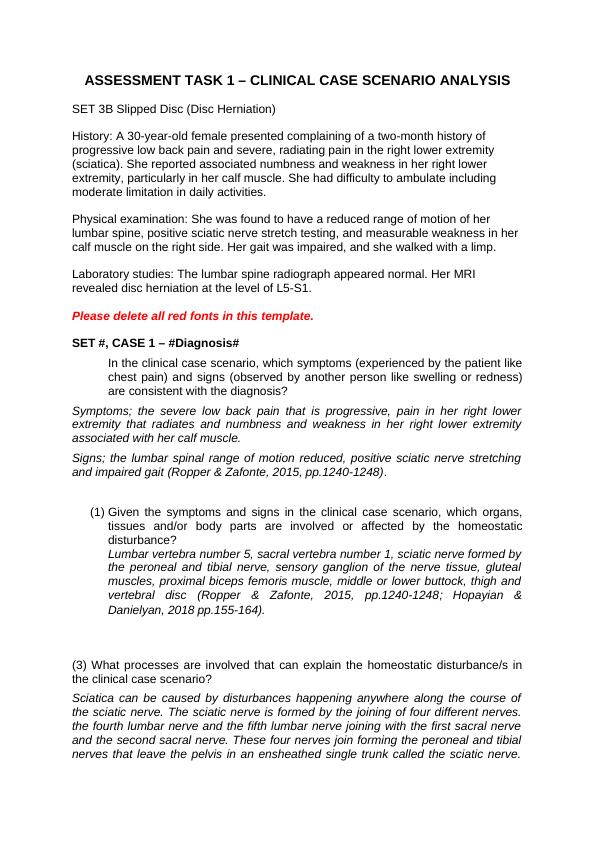Clinical Case Scenario Analysis: Slipped Disc (Disc Herniation)
Added on 2023-03-20
3 Pages1154 Words98 Views
ASSESSMENT TASK 1 – CLINICAL CASE SCENARIO ANALYSIS
SET 3B Slipped Disc (Disc Herniation)
History: A 30-year-old female presented complaining of a two-month history of
progressive low back pain and severe, radiating pain in the right lower extremity
(sciatica). She reported associated numbness and weakness in her right lower
extremity, particularly in her calf muscle. She had difficulty to ambulate including
moderate limitation in daily activities.
Physical examination: She was found to have a reduced range of motion of her
lumbar spine, positive sciatic nerve stretch testing, and measurable weakness in her
calf muscle on the right side. Her gait was impaired, and she walked with a limp.
Laboratory studies: The lumbar spine radiograph appeared normal. Her MRI
revealed disc herniation at the level of L5-S1.
Please delete all red fonts in this template.
SET #, CASE 1 – #Diagnosis#
In the clinical case scenario, which symptoms (experienced by the patient like
chest pain) and signs (observed by another person like swelling or redness)
are consistent with the diagnosis?
Symptoms; the severe low back pain that is progressive, pain in her right lower
extremity that radiates and numbness and weakness in her right lower extremity
associated with her calf muscle.
Signs; the lumbar spinal range of motion reduced, positive sciatic nerve stretching
and impaired gait (Ropper & Zafonte, 2015, pp.1240-1248).
(1) Given the symptoms and signs in the clinical case scenario, which organs,
tissues and/or body parts are involved or affected by the homeostatic
disturbance?
Lumbar vertebra number 5, sacral vertebra number 1, sciatic nerve formed by
the peroneal and tibial nerve, sensory ganglion of the nerve tissue, gluteal
muscles, proximal biceps femoris muscle, middle or lower buttock, thigh and
vertebral disc (Ropper & Zafonte, 2015, pp.1240-1248; Hopayian &
Danielyan, 2018 pp.155-164).
(3) What processes are involved that can explain the homeostatic disturbance/s in
the clinical case scenario?
Sciatica can be caused by disturbances happening anywhere along the course of
the sciatic nerve. The sciatic nerve is formed by the joining of four different nerves.
the fourth lumbar nerve and the fifth lumbar nerve joining with the first sacral nerve
and the second sacral nerve. These four nerves join forming the peroneal and tibial
nerves that leave the pelvis in an ensheathed single trunk called the sciatic nerve.
SET 3B Slipped Disc (Disc Herniation)
History: A 30-year-old female presented complaining of a two-month history of
progressive low back pain and severe, radiating pain in the right lower extremity
(sciatica). She reported associated numbness and weakness in her right lower
extremity, particularly in her calf muscle. She had difficulty to ambulate including
moderate limitation in daily activities.
Physical examination: She was found to have a reduced range of motion of her
lumbar spine, positive sciatic nerve stretch testing, and measurable weakness in her
calf muscle on the right side. Her gait was impaired, and she walked with a limp.
Laboratory studies: The lumbar spine radiograph appeared normal. Her MRI
revealed disc herniation at the level of L5-S1.
Please delete all red fonts in this template.
SET #, CASE 1 – #Diagnosis#
In the clinical case scenario, which symptoms (experienced by the patient like
chest pain) and signs (observed by another person like swelling or redness)
are consistent with the diagnosis?
Symptoms; the severe low back pain that is progressive, pain in her right lower
extremity that radiates and numbness and weakness in her right lower extremity
associated with her calf muscle.
Signs; the lumbar spinal range of motion reduced, positive sciatic nerve stretching
and impaired gait (Ropper & Zafonte, 2015, pp.1240-1248).
(1) Given the symptoms and signs in the clinical case scenario, which organs,
tissues and/or body parts are involved or affected by the homeostatic
disturbance?
Lumbar vertebra number 5, sacral vertebra number 1, sciatic nerve formed by
the peroneal and tibial nerve, sensory ganglion of the nerve tissue, gluteal
muscles, proximal biceps femoris muscle, middle or lower buttock, thigh and
vertebral disc (Ropper & Zafonte, 2015, pp.1240-1248; Hopayian &
Danielyan, 2018 pp.155-164).
(3) What processes are involved that can explain the homeostatic disturbance/s in
the clinical case scenario?
Sciatica can be caused by disturbances happening anywhere along the course of
the sciatic nerve. The sciatic nerve is formed by the joining of four different nerves.
the fourth lumbar nerve and the fifth lumbar nerve joining with the first sacral nerve
and the second sacral nerve. These four nerves join forming the peroneal and tibial
nerves that leave the pelvis in an ensheathed single trunk called the sciatic nerve.

End of preview
Want to access all the pages? Upload your documents or become a member.
Related Documents
Nursing Paper on Sciatica and Liver Dysfunctionlg...
|10
|3465
|35
Low Back Pain Physiologylg...
|4
|985
|409
